How To Set Up A Epiphone Les Paul
For decades, dejection and rock guitarists have been laying glass or metal cylinders across their strings to add expressive riffs to their music. Unlike a Dobro or lap steel, which is played horizontally with a bar and has its strings jacked up style off the fretboard, a standard vi-string guitar can be set up for both fretting and slide work—if you know what you're doing.
Let's explore how to finesse a guitar so its strings sit high plenty to keep a slide from crashing into the frets, yet remain close enough to the fretboard that you can play chords and riffs with your fingertips. Aye, y'all tin have it all, as Duane Allman, Johnny Winter, Sonny Landreth, Ry Cooder, Derek Trucks, and many other greats have proven over the years.
It's non too hard to fix an electrical guitar for dual duties, so that's what nosotros'll focus on. Information technology's more of a challenge with an acoustic, but with a little ingenuity, yous tin can likewise suit the following techniques to a flattop, so read on.
Projection overview.
To illustrate the steps, I'll use a 2003 Gibson Les Paul Studio (Photo 1) a client brought in to have converted into a ripping slide guitar. He wanted to stick with his moderately light .010–.049 strings then he could comp and solo as usual, but he besides wanted to augment his standard riffage with slide licks when the spirit moved him.
To make this happen, I suggested he use a lightweight, direct-wall drinking glass slide—like to Allman and Trucks—every bit opposed to the heavier contumely or bottleneck slides that are oft favored by acoustic resonator guitarists. Why? Using a lightweight slide, such every bit a Dunlop Derek Trucks Signature medicine bottle or the aluminum BigHeart Firecracker, makes it possible to employ slinkier strings and keep the activity reasonably depression. Heavier slides can sound great, but they demand stouter strings and stiffer action. A calorie-free slide allows you to find that sweet spot in your setup where you can apply the same guitar for 2 very different techniques.
Preliminary measurements.
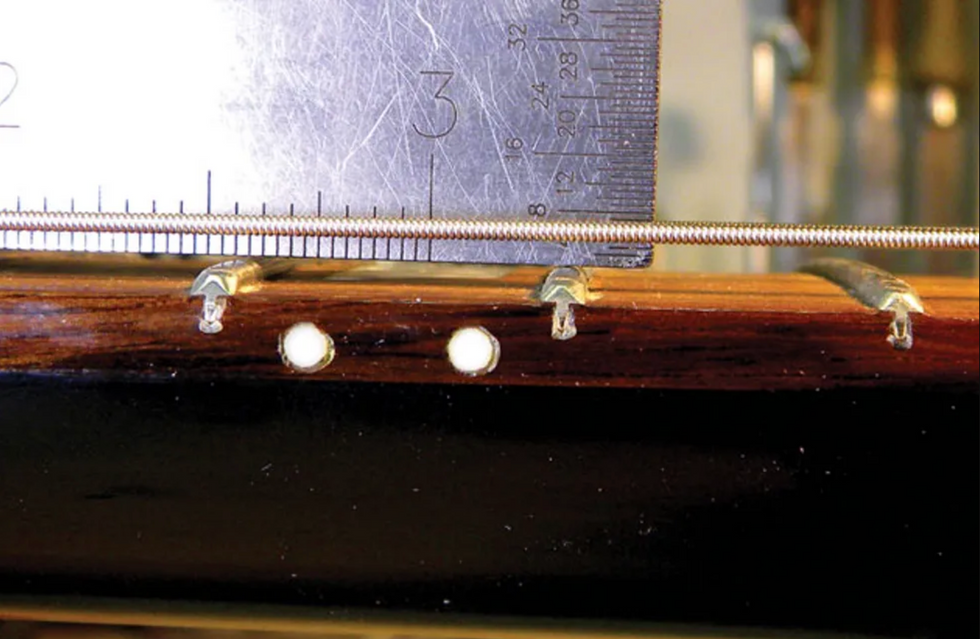
Photo 2
The first step is to measure iii things: action at the 12th fret, neck relief, and string height at the 1st fret. These measurements volition provide a baseline to work from.
Here'due south the process: To measure the action, first melody to pitch (this is crucial) and so place a capo on top of the 1st fret. Adjacent use a precision metallic ruler to measure the string superlative at the 12th fret. I utilise a Cord Action Gauge—a handy tool from Stewart MacDonald—(Photo two) for this. You want to decide the distance between the top of the 12th fret and the lesser of both the 6th and 1st strings.
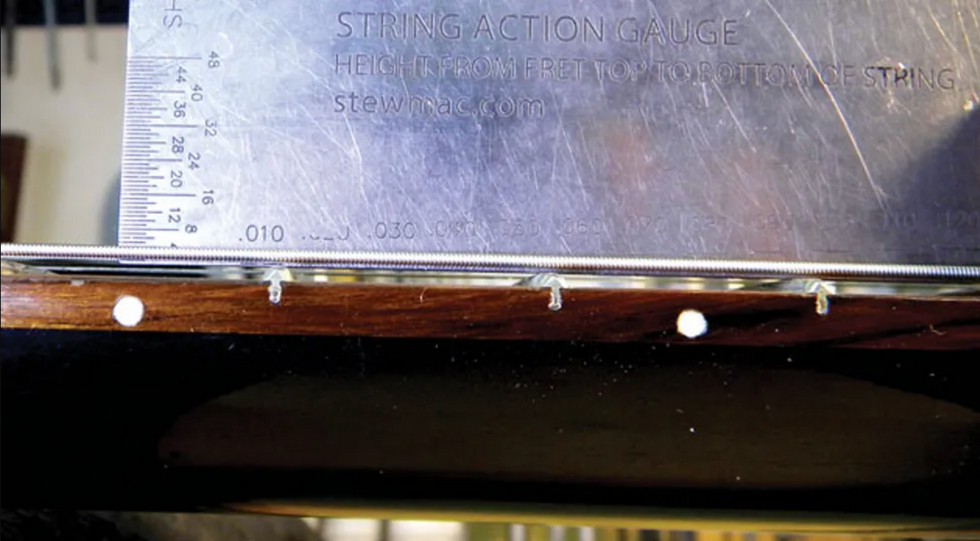
Photo iii
On this Les Paul, the gap was 3/64" for the 1st string and 4/64" for the 6th. This action is comfortable for my customer, only too low for slide.
Now to measure the amount of relief. With the capo nonetheless on the 1st fret, hold down the 6th string at the last fret and measure the greatest distance between the lesser of the string and the tiptop of the frets (Photo iii).
On my client's guitar, the relief was .012"—perfect for his current playing style and too fine for supporting a lightweight slide. If your guitar has less relief, you may demand to loosen the truss rod very slightly to introduce a tad more forwards bow. (Read "Fourth dimension for a Neck Aligning?" to larn more than about working with a truss rod.) But before y'all accept that road, first complete the setup I'm well-nigh to depict. It's quite possible these steps will be all you'll need to enter the slide zone.
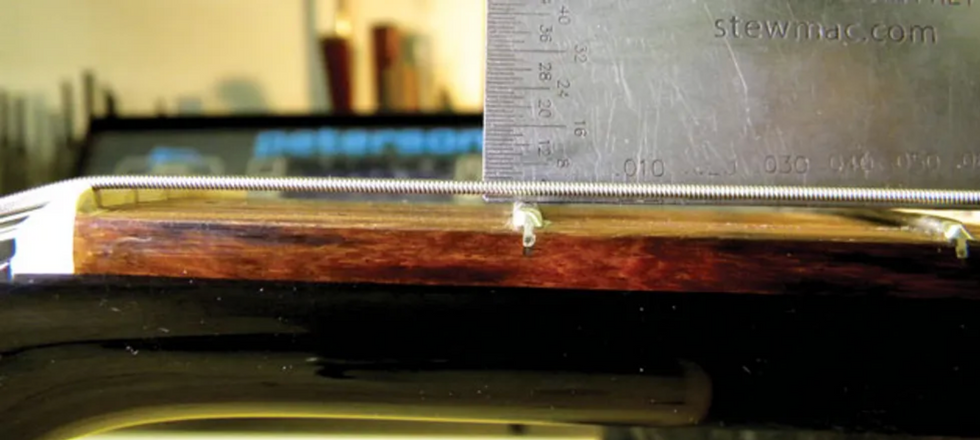
Photo four
Next, remove the capo (information technology wouldn't hurt to confirm your strings are nonetheless at pitch) and measure the height of the 1st and sixth strings at the 1st fret (Photo four).
In this case, the tiptop was 1/64" and two/64" for the 1st and sixth strings, respectively. While this is ideal for fretting chords and lines, it's also low for playing slide.
From these preliminary measurements, I was able to determine what would be required to requite this Les Paul its new dual identity:
- Raise the activity at the bridge and and so adjust individual saddles.
- Raise the action at the nut by either shimming the stock nut or carving a new one.
- Adjust the pickups to balance string-to-cord volume.
- Arrange the intonation.
Adjust the bridge.
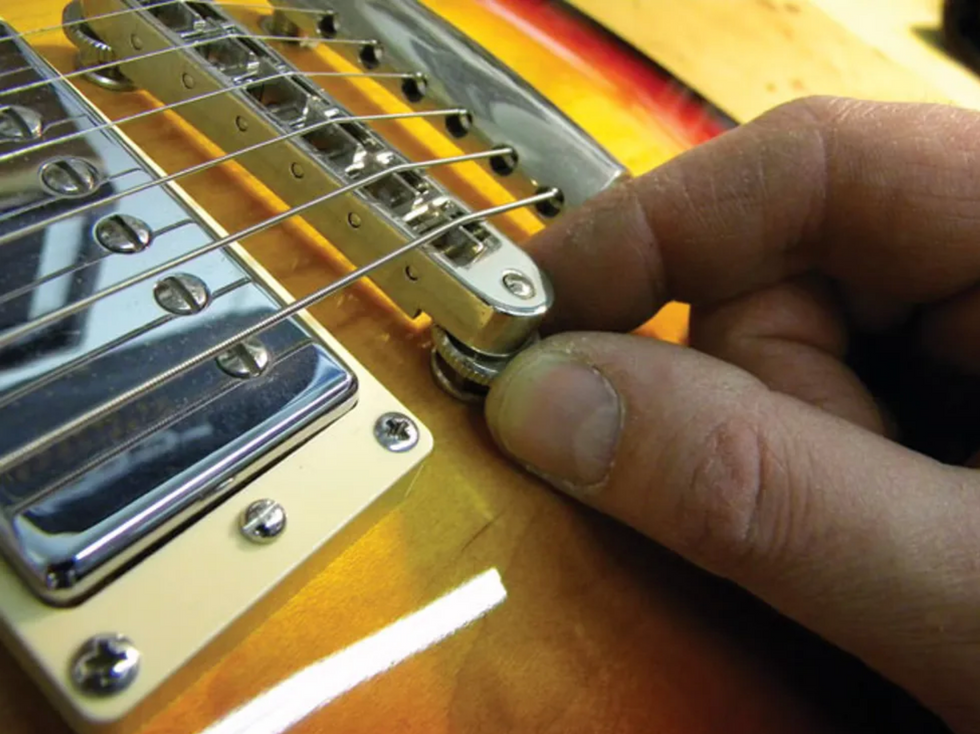
To heighten the action on a Les Paul's Tune-o-matic span, plow the thumbwheels counter-clockwise (Photo v). Exercise this in small increments, maybe a quarter of a rotation for each thumbwheel. Retune the guitar, put a capo on the 1st fret, and then measure the activeness at the 12th fret again.
For starters, I advise adjusting the activeness to 4/64" on both the 1st and 6th strings. Call back, you can e'er come up back and raise the treble or bass strings a chip more if you notice your slide is hitting the frets.
Adjust the saddles.
At present here's our outset tricky part. Almost lightweight slides (such every bit a glass or chrome tube, or the medicine bottle favored by Allman and Trucks) contact the strings in a directly line. However, on a guitar set for fretting—including my client's LP—the strings follow the fretboard radius or curvature. In other words, strings 1 through 6 are subtly biconvex at the bridge so they sit at a consistent height above the frets.
Slide licks oftentimes contain two or three strings at a time. When your slide has a directly playing surface, all the same the strings are arched, you'll wind up pressing some strings downward more than others as you move across the fretboard. This can create subtle intonation problems within a chord or interval.
Yes, you lot tin can have it all, as Duane Allman, Johnny Winter, Sonny Landreth, Ry Cooder, Derek Trucks, and many other greats accept proven over the years.
The solution is to flatten the string radius at the span so the strings sit in a straight line that corresponds to the slide's playing surface. On a guitar with individually adjustable saddles, like a Strat, it's like shooting fish in a barrel to raise or lower each string to achieve the target four/64" gap betwixt the lesser of all the strings and the top of the 12th fret.
However, on a guitar with a fixed-radius bridge—such as a Les Paul with a Melody-o-matic—some saddle slots will need to exist deepened slightly to create a flat line between strings 1 and 6. Typically it'south the middle saddles that need attention, but your current bridge radius and string gauges will determine which slots require recutting and by how much.
Gauged nut slotting files, which are bachelor from Allparts, Stewart-MacDonald, and other luthier suppliers, work bully for this task because you can precisely size the slot to match the string. For example, knowing that my client plays a .010–.046 set, I'll use a .036 gauge nut file to deepen the notch for the .036 A string.
The process is pretty straightforward: Afterward you've set up the span so the 1st and 6th strings are four/64" to a higher place the 12th fret, measure out the 2nd string. If it's as well 4/64" at the 12th fret, motion onto the 3rd string. Merely if it'southward higher, carefully deepen the slot to bring the 2nd string downward to 4/64".
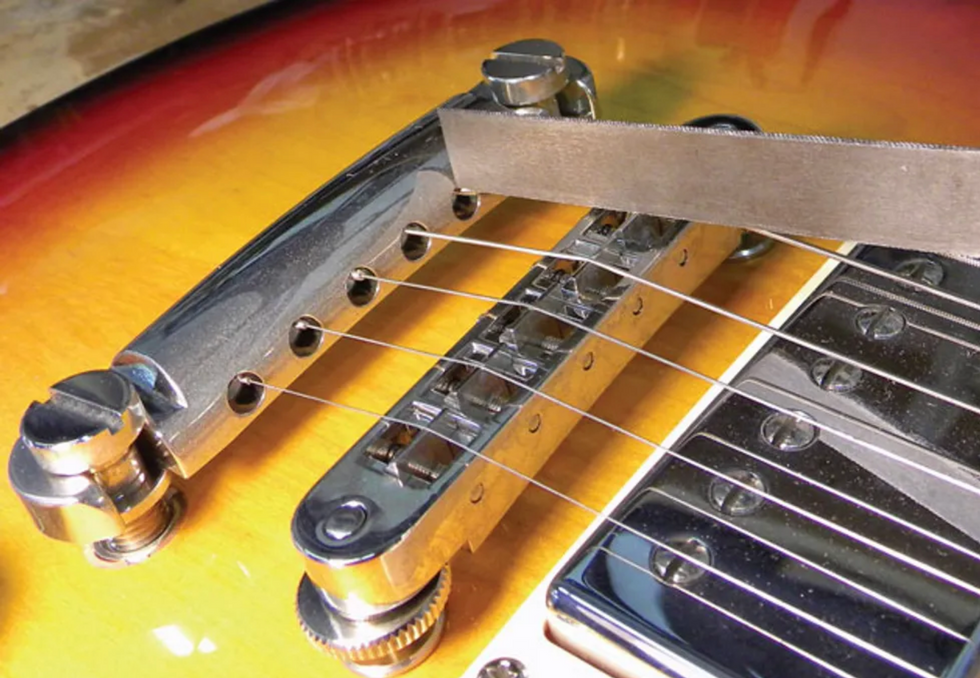
Photo 6
When re-cut a notch, always follow the bending of the string as it emerges from the tailpiece up to the saddle (Photo 6). Go slowly, retuning and then measuring the action every few file strokes. Gently clean off any burrs on the front or back of the saddle using the nut file. This will prevent the cord from getting caught up on the saddle and creating tuning issues.
Echo the process on each inside string until you've accomplished a uniformly level playing surface beyond all six strings. It's painstaking work, but the payoff in tone and feel volition be worth the attempt. Once you've flattened the radius and are satisfied with the overall activity, you'll be ready to motility over to the nut.
Heighten the nut.
From experience, I knew that having the 1st string sit 1/64" in a higher place the 1st fret is too low for slide, then I'd demand to enhance the nut on this Les Paul. The trick, of course, is to become the nut high enough to accommodate slide technique, nonetheless not make the guitar unplayable when fretting. Based on the owner'southward playing style, string gauges, and low-cal drinking glass slide, I decided on a uniform height of 2/64" for all 6 strings on his guitar.
At that place are merely ii ways to correctly and permanently raise the nut: You can shim it or carve a new one. The owner wanted to go along the stock Gibson nut, which was in splendid status, then we elected to shim it.
Here's how that works: Offset remove the nut by gently tapping it on the fretboard side with a flathead screwdriver and small hammer (Photo seven). Next, clean up the nut slot by removing the backlog gum with a small chisel or razor knife, and and then scrape whatsoever mucilage off the nut.
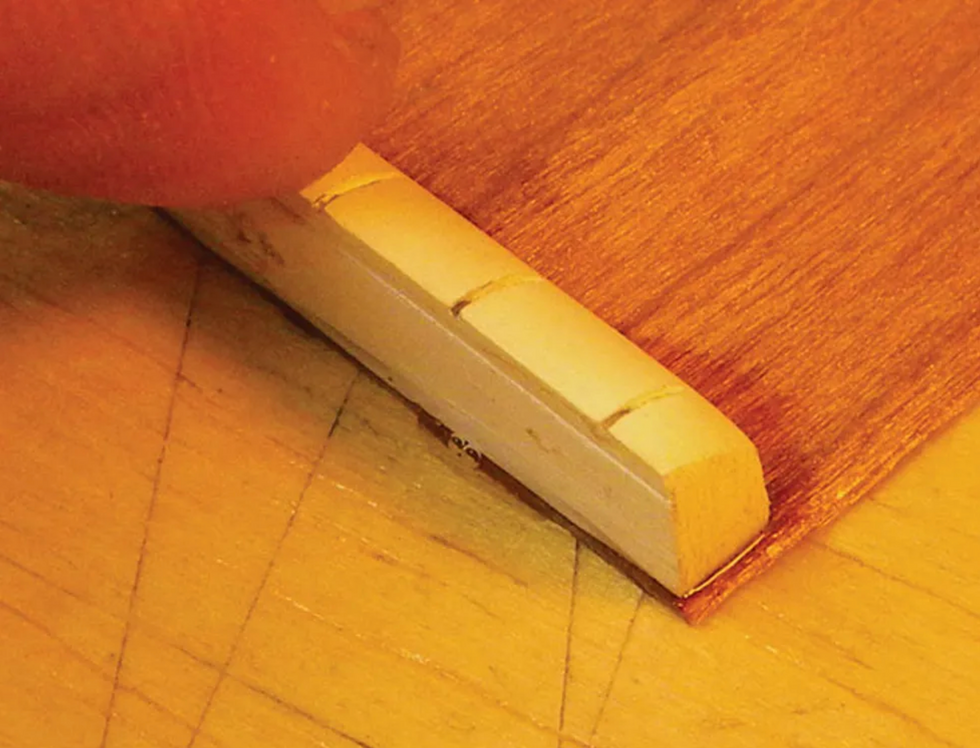
Photo 8
Now super-mucilage the nut onto a sparse piece of mahogany (Photo 8). For this kind of shim, I use a .020" thick slice of wood.
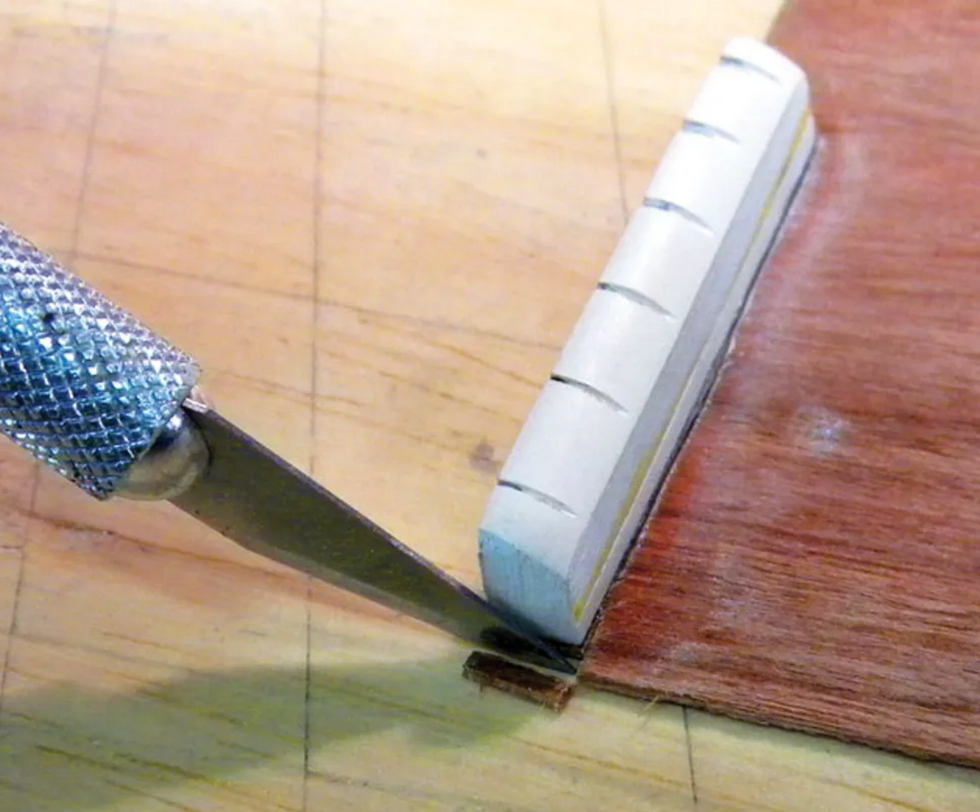
Trim off the excess wood around the string nut with a razor knife (Photo ix). Install the string nut and secure it with 1 drop of super gum on the face of the nut between the 4th and 3rd strings.
Retune the guitar and and so start with the 1st string, measure out the action at the 1st fret. Remember, this measurement is from the top of the fret to the lesser of the string. Using gauged nut files, recut each slot and then its corresponding cord sits at the new target height of 2/64" to a higher place the 1st fret. One at a time, slowly deepen each slot, carefully maintaining the angle of the cord as information technology heads toward the tuner. After a few passes with the file, identify the cord in the slot, retune, and mensurate the action at the 1st fret once more. Repeat this process for each string using the proper nut file for each string gauge.
Suit the pickups.
Afterwards yous alter the action on a guitar—especially to this degree—it's a practiced idea to conform the pickups to make sure the treble-to-bass and string-to-string balance is how you want it.

First outset with overall pickup height. Concord the 1st and sixth strings down at the last fret and measure the altitude from the bottom of the strings to the top of the pickup. The distances in this table provide a good starting point for humbuckers.
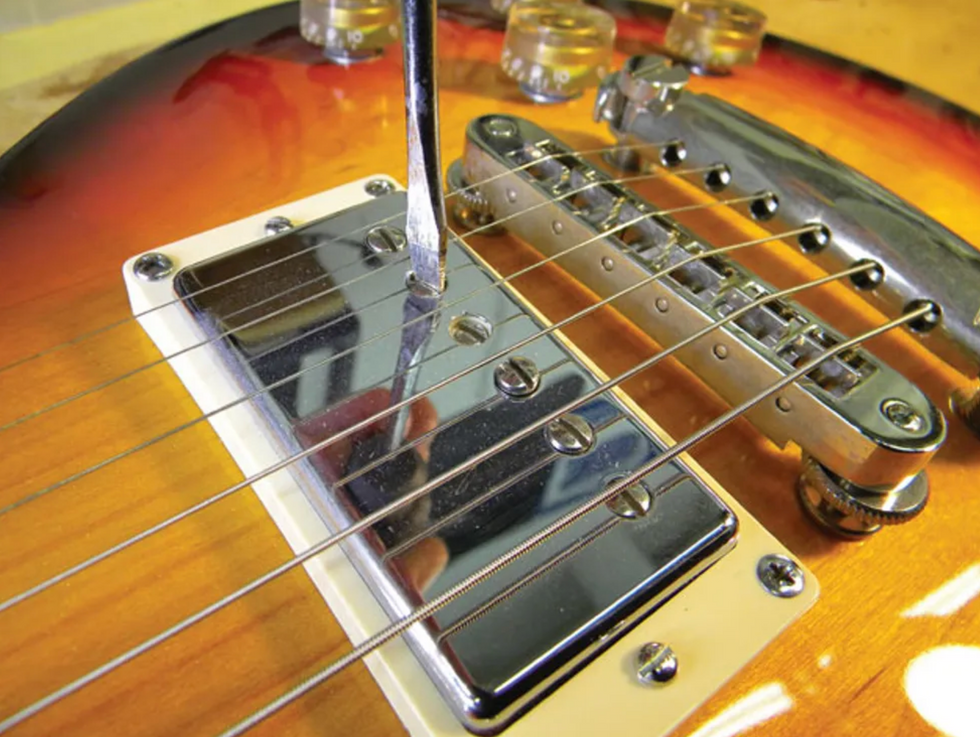
Photo 10
The next pace is to adjust the individual pole pieces using a small flathead screwdriver (Photograph ten). The goal hither is to create an fifty-fifty and consequent string-to-string balance.
Begin with the fifth cord pole piece and accommodate it to match the volume of the 6th string. Raising the pole slice will make a string louder and vice versa. And then move to the 4th string and compare it to strings 6 and 5. Proceed working across the strings, checking them relative to each other and making pocket-sized tweaks as necessary. Typically, the tertiary string is the loudest, so don't be surprised if you wind up lowering it beneath the pickup cover to continue it in residuum with the other strings.
It's a wrap.
The last stride to complete the project is install a new set up of strings, tune to pitch, and adjust the intonation. If you need instructions for checking and adjusting the intonation, read "How to Install a New Tune-o-matic Span."
With the cord top and pickups adjusted for playing slide, our projection Les Paul is set to return to its possessor. But before he carts it off, I'll listen to him play and run across if the bridge height and pickup pole pieces are dialed in to his satisfaction. If you lot set up your own guitar for double duty, you lot may find yourself making small adjustments subsequently playing it for a few days. That's the beauty of being your ain tech, right? That said, if you lot're not confident y'all can safely work with mucilage, files, and other tools around your guitar, take it to your local pro.
[Updated 11/18/21]
Source: https://www.premierguitar.com/diy/guitar-shop-101/how-to-adjust-action-on-les-paul

0 Response to "How To Set Up A Epiphone Les Paul"
Post a Comment